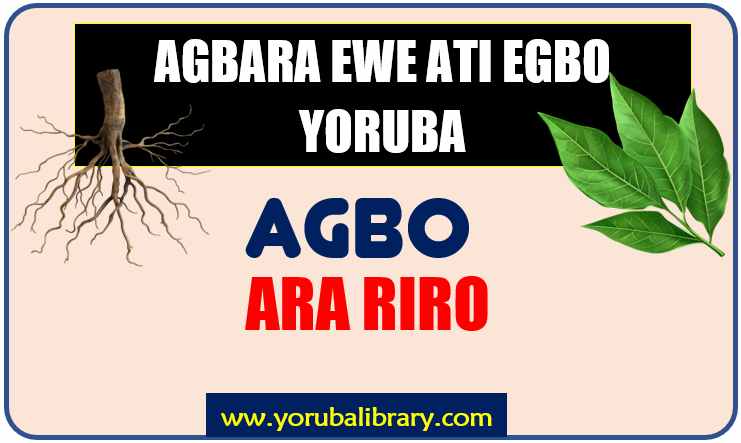
support@yorubalibrary.com
+2348073529208, 07038599574

Among the Yoruba people, body ache (ara riro) is viewed as more than ordinary tiredness. It is a sign that the body system is disturbed — either from stress, fever, cold, or excessive physical work. Yoruba healers believed that when the body is in pain, it is the body’s way of calling for attention and balance. Our forefathers treated body ache with knowledge of herbs that relieve pain, reduce internal heat, and restore natural body comfort. The most popular preparation for this condition is Agbo Ara Rirọ, a decoction made from selected leaves, roots, and barks. This herbal mixture works to calm internal inflammation and strengthen the body.
Our forefathers treated body ache with knowledge of herbs that relieve pain, reduce internal heat, and restore natural body comfort. The most popular preparation for this condition is Agbo Ara Rirọ, a decoction made from selected leaves, roots, and barks. This herbal mixture works to calm internal inflammation and strengthen the body.
Disclaimer
Yoruba Library and its Team will not be held liable for improper usage or any loss arising from improper use, wrong application, inability to find needed materials, or misinterpretation of this article. This article is provided strictly for guidance and educational purposes.
Symptoms Observed by Our Forefathers
When a person was suffering from ara riro (body ache), some common signs noticed by Yoruba elders included:
• General body weakness or heaviness.
• Pain in joints, waist, and shoulders.
• Feverish feeling without visible cause.
• Difficulty in movement or stiffness after rest.
• Loss of appetite and tiredness even without much work.
How Our Forefathers Treated Body Ache in the Past
Yoruba traditional healers relied on herbal understanding. Their treatments focused on restoring physical comfort and internal balance through purely natural means:
1) Herbal Decoctions (Agbo):
Roots and leaves known for pain relief were boiled together and taken warm. Amongst the notable roots and leaf necessary when preparing Agbo Ara Riro include:
1) Ewe Dongoyaro
2) Ewe Rinrin
3) Ewe Akoko
4) Ewe Osepotu
5) Ewe Jenjoko
6) Ewe Akerejupon
7) Ewe Abamoda
8) Ewe Sapo
9) Ewe Aiku
Have you heard of Yoruba Herb Dictionary? This contains names of Yoruba Leaf, Roots, Barks, Characteristics, Properties & Identification with HD Pictures. Order below or download sample here
A-Z HERBS & LEAF DICTIONARY #4KOne Yoruba proverb says "Bí olóde ò kú, òde rè kì í wu Gbégi". Do you know that Gbégi is actually a leaf/plant? Get Yoruba Proverbs on Plants and Herbs, which is a collection of Untold Wisdoms Hidden in Leaf and plants comprising their Life Applications & Moral Teachings. Order below or download sample here
YORUBA PROVERBS ON PLANTS #4KThe Healing Process in Traditional Practice
Treatment for body ache was never random. Yoruba healers followed careful steps to ensure safety and effectiveness:
1) Timing of Herb Collection – Herbs were gathered early in the morning or during calm hours when their natural strength was believed to be highest.
2) Preparation and Administration – Selected herbs were washed, boiled, and strained. The patient took the warm decoction morning and night until the body regained comfort.
3) Rest and Diet – Patients were advised to rest properly, drink enough water, and avoid heavy or oily foods while using the medicine.
4) Observation – The healer monitored improvement daily, adjusting the quantity or strength of the decoction as needed.
Differences Between Yoruba and Modern Treatment
• Focus of Healing –
Yoruba medicine treats pain by cleansing and balancing the body naturally, while modern treatment targets symptoms using drugs.
• Materials Used –
Yoruba practice uses roots, leaves, and oils; modern medicine uses synthetic painkillers or anti-inflammatory drugs.
• Approach to Recurrence –
Yoruba method also strengthens the body against future stress, while modern medicine often provides temporary relief.
• Cultural Value – Yoruba healing connects wellness to nature and wisdom, maintaining cultural respect for natural medicine.
Safety First: Important Contraindications and Considerations
1) Pregnancy and Lactation –
Some potent herbs are unsafe for pregnant or breastfeeding women. Elders insisted these must never be used during this time.
2) Underlying Conditions –
Individuals with kidney, liver, or chronic health challenges should not take strong decoctions without special guidance.
3) Source Quality –
Plants grown with chemicals, pesticides, or harvested from polluted areas carry harm instead of healing. The source must be trusted.
4) Children –
Young children should only be given mild herbal extracts under close supervision.
Needed Materials (Leaves, Roots, Bark, etc.)
The medicinal approach for this requires careful selection of natural materials traditionally known to our elders. These are combined to ensure potency.
The instruction you will receive is the original account of our forefathers, preserved and tested over time. Many people have used them with testimonies of relief. Just ensure you follow the correct guidelines. Click Unlock Secret below
Application Process
The strength of Yoruba medicine depends on how materials are handled. Proper pounding, boiling, or steeping — done in the right way and at the right time — ensures the remedy remains potent. Click Unlock Secret below
Uses
The prepared remedy must be applied in the correct manner — whether for drinking, steaming, bathing, or chest rubbing — and taken in the right dosage for it to remain effective.
1) Some leaf required special utterances/chants before they can be effective. Where applicable, this will be stated in the PDF
2) The methods of getting the needed items like leaf, bark, roots by yourself is covered in the PDF
3) Saa bi Ologun ti wi, ki o le baa je... (Follow instructions for it to remain potent). You're getting a Real and Original account of our fore fathers.
With Numerous Satisfied Clients...